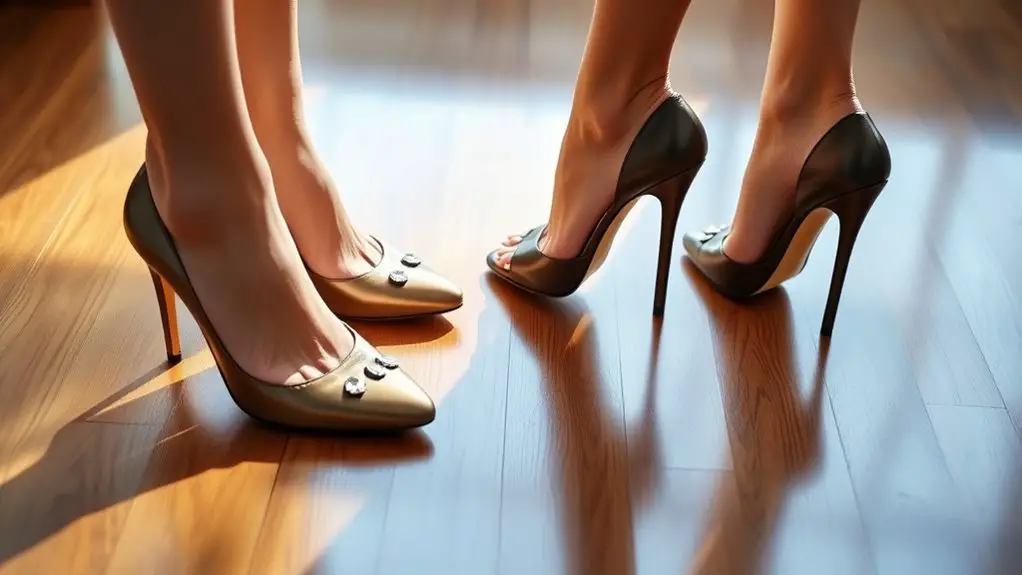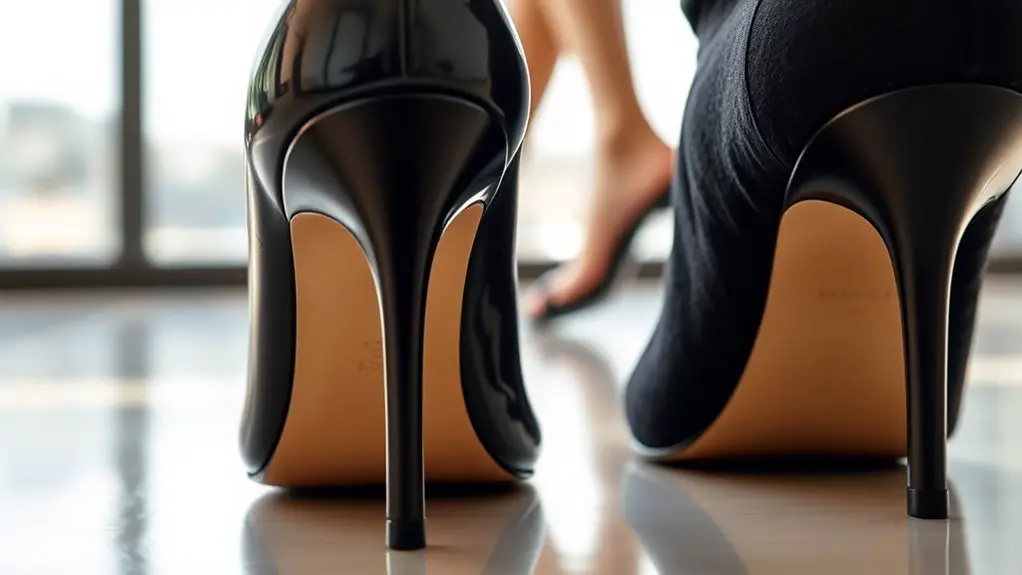Some heels feel more comfortable than others due to factors like heel height, arch support, and material. Higher heels often shift your weight forward, straining your feet, while well-designed heels balance weight and reduce pressure points. Proper fit—considering size and toe box space—is essential, as is the heel design, which affects stability. Additionally, the fabric used can influence flexibility and breathability. Understanding these elements can enhance your heel-wearing experience, with more insights available in the following sections.
Understanding Heel Height and Its Impact on Comfort

When you think about comfort in heels, heel height is often the first factor that comes to mind, as it can considerably affect how your feet feel throughout the day. Heel mechanics play a significant role in this dynamic; the higher the heel, the more your body weight shifts forward, which can strain your toes and arch. Generally, lower heels tend to distribute weight more evenly, reducing discomfort. However, an ideal height varies for each person based on comfort factors like foot shape and individual balance.
A 2-3 inch heel might offer a good compromise between style and comfort for many, while others may find even lower options more suitable. It’s essential to take into account not just aesthetics but also how the heel height interacts with your unique biomechanics. Ultimately, understanding these variables can help you make informed decisions about which heels will best accommodate your needs.
The Role of Arch Support in Heel Comfort
While heel height greatly influences comfort, arch support is another critical factor that shouldn’t be overlooked. Proper arch support can greatly enhance your comfort levels by distributing weight evenly across your foot, reducing strain on your arches, and preventing fatigue. Without adequate support, you may experience discomfort or pain, particularly during prolonged wear.
Here’s a breakdown of different arch support types and their impact on comfort levels:
| Arch Support Type | Comfort Level (1-5) | Recommended Use |
|---|---|---|
| None | 1 | Casual flats |
| Minimal | 2 | Low heels |
| Moderate | 3 | Mid-height heels |
| Enhanced | 4 | Platform heels |
| Maximum | 5 | Specialty support shoes |
Understanding how different levels of arch support affect your comfort can guide you in selecting the right heels for your needs.
Material Matters: The Influence of Fabrics and Cushions

When choosing comfortable heels, the materials used can greatly affect your experience. Fabrics that offer flexibility and breathability allow your feet to move naturally while keeping them cool, which is essential for extended wear. Additionally, understanding the differences in cushioning technology can help you select heels that provide the right balance of support and comfort.
Fabric Flexibility and Breathability
Although many factors contribute to the comfort of heels, the choice of fabric plays a pivotal role in ensuring flexibility and breathability. Heels made from breathable materials allow air circulation, reducing moisture and discomfort. Meanwhile, flexible fabrics adapt to your foot’s shape, providing a snug fit without constriction.
| Fabric Type | Benefits |
|---|---|
| Leather | Durable, molds to foot |
| Mesh | Highly breathable, lightweight |
| Suede | Soft, offers some stretch |
| Canvas | Flexible, easy to clean |
| Synthetic | Versatile, often water-resistant |
Selecting the right combination of these materials can greatly enhance your overall comfort, making a noticeable difference in your experience with heels.
Cushioning Technology Differences
How do different cushioning technologies affect the comfort of heels? The choice of cushioning materials is essential for your overall foot comfort. Heels that utilize advanced foam technologies, like memory foam or gel, provide superior impact absorption. These materials mold to your foot’s shape, reducing pressure points and enhancing stability. In contrast, cheaper alternatives may offer minimal cushioning, leading to discomfort and fatigue over time. Additionally, the thickness and density of these materials can greatly influence how heels feel during prolonged wear. A well-cushioned heel not only supports your feet but also promotes better posture. By understanding these differences, you can select footwear that prioritizes comfort without sacrificing style, ensuring a more enjoyable wearing experience.
The Importance of Fit: How Size and Shape Affect Comfort
When it comes to comfortable heels, proper shoe sizing is essential; wearing the right size can prevent unnecessary pain and discomfort. Additionally, adequate arch support and sufficient toe box space play significant roles in overall foot health and stability. Understanding how these factors interact can help you make informed choices for a more comfortable experience.
Proper Shoe Sizing
Finding the right shoe size is vital for guaranteeing comfort throughout the day, as even slight variations in fit can lead to discomfort or pain. Accurate shoe measurements are essential; using size charts helps you identify your correct size based on your foot shape. Remember, everyone’s feet are unique—what fits one person perfectly might not work for you. Employ fitting techniques like measuring both feet, as one may be larger than the other. Don’t hesitate to try on different styles and brands, as sizes can vary considerably. Prioritizing proper sizing guarantees that your heels provide the support you need, minimizing the risk of blisters or other foot issues, and ultimately enhancing your overall comfort.
Arch Support Importance
Proper shoe sizing lays the groundwork for comfort, but the shape of your foot and its arch plays a significant role in how well your heels perform. Understanding your arch type—whether it’s flat, neutral, or high—can help determine the arch support benefits you need. For instance, if you have a high arch, shoes with adequate support can alleviate pressure and reduce fatigue. Conversely, flat arches often require additional cushioning to prevent discomfort. When heels lack proper arch support, you’re more likely to experience pain and instability. By selecting shoes that accommodate your specific arch type, you enhance overall comfort and reduce the risk of injury, making heel-wearing a more enjoyable experience.
Toe Box Space
While many people focus on heel height and arch support, toe box space is equally essential for overall comfort. The toe box design plays a significant role in how your feet feel throughout the day. A well-designed toe box allows your toes to spread naturally, reducing pressure and discomfort. If the toe box width is too narrow, it can lead to issues like bunions or blisters, making your heels unbearable. Conversely, a roomier toe box can enhance breathability and mobility, allowing for a more pleasant walking experience. When selecting heels, pay close attention to both the design and width of the toe box to guarantee it accommodates your foot shape properly, assuring comfort without sacrificing style.
Heel Design: The Effect of Shape and Structure
Heel design plays an essential role in determining both the aesthetic appeal and comfort of footwear. When you consider heel shape, think about how variations like stiletto, block, or kitten heels affect your overall experience. A wider base, for instance, typically provides better stability, whereas a narrow shape can lead to discomfort over time.
Equally important is heel structure. The materials and construction techniques used influence not just style but also support. A well-structured heel incorporates cushioning and arch support, which can greatly reduce strain on your feet.
Additionally, the angle of the heel impacts weight distribution and posture, affecting how you walk and stand. A balanced heel structure aligns your body correctly, reducing fatigue. When selecting heels, pay attention to these design elements, as they can mean the difference between a stylish look and a painful experience.
The Science of Weight Distribution in Heels

Understanding how weight distribution works in heels is essential for both comfort and stability. When you wear heels, your body weight shifts from the heel to the ball of your foot. This shift can create pressure points, particularly if the shoe’s design doesn’t effectively distribute your weight. A well-designed heel should ideally balance weight across the foot to minimize discomfort.
If the weight is concentrated on specific areas, it can lead to pain and fatigue. For instance, narrow heels often exacerbate pressure points, while wider bases help in distributing weight evenly. The materials used in the heel and the cushioning also play a significant role in how your weight is managed. Shoes that incorporate arch support or shock-absorbing materials can enhance comfort by alleviating pressure on sensitive areas. By understanding these principles of weight distribution, you can choose heels that not only look good but also feel good to wear.
The Impact of Toe Box Space on Comfort
Weight distribution is just one factor influencing comfort in heels, but the design of the toe box is equally important. The toe box dimensions play an essential role in how your toes interact within the shoe. A wider toe box allows for natural toe splay, which can greatly enhance comfort. When your toes have room to spread out, it reduces pressure points that can lead to pain and discomfort during wear.
Conversely, a narrow toe box can constrict your foot, leading to cramping and fatigue. If you’re considering a new pair of heels, evaluate the toe box dimensions carefully. Ideally, you want a design that accommodates your foot’s natural shape, allowing for adequate splay without compromising the shoe’s aesthetic. Remember, the right toe box can make all the difference in how enjoyable your heel-wearing experience is. Prioritize comfort by choosing styles that respect your foot’s anatomy.
Finding the Right Balance: Stiletto vs. Chunky Heels
When choosing between stilettos and chunky heels, it’s essential to reflect on not just the aesthetic appeal but also how each style affects your comfort and stability. Stilettos offer a sleek, elegant silhouette, but their narrow base can compromise stiletto stability, making you more susceptible to wobbling or discomfort after prolonged wear. On the other hand, chunky heels provide a wider support base, enhancing stability and allowing for longer wear without significant strain. They bring chunky versatility to your wardrobe, easily shifting from casual to formal settings.
However, it’s vital to weigh your foot type and personal comfort preferences. If you’re accustomed to wearing heels, stilettos may not pose as much of a challenge, while those new to heels could benefit from the added support of chunky styles. Ultimately, balancing style with comfort will lead you to the right choice, ensuring you feel confident and at ease in your footwear.
Tips for Choosing Comfortable Heels for Different Occasions
Choosing the right heels for different occasions can greatly impact your comfort and confidence throughout the day. To guarantee you’re making the best choice, consider occasion specific styles. For formal events, opt for classic pumps with a moderate heel height for elegance without sacrificing comfort. On the other hand, if you’re attending a casual outing, look for block heels or wedges, which provide more stability and support.
Don’t overlook heel alternatives like stylish flats or low-heeled sandals, especially for long days. When shopping, pay attention to the material; softer leathers and cushioned insoles can enhance comfort considerably. Also, consider the toe shape; rounded or almond toes tend to offer more room compared to pointed designs. Ultimately, it’s essential to select heels that match both your outfit and the setting, guaranteeing you feel comfortable, confident, and ready to take on the day.
Frequently Asked Questions
Can Heel Height Affect My Posture and Back Pain?
Yes, heel height can considerably affect your posture and back pain. Proper heel biomechanics influence posture alignment, which can either alleviate or exacerbate discomfort. Finding the right height is essential for maintaining a healthy spine and overall comfort.
How Do Different Heel Brands Compare in Comfort?
Choosing heels is like picking a fine wine; each brand offers unique comfort ratings. When comparing brands, consider materials, design, and cushioning. Some prioritize style over comfort, while others blend both beautifully, affecting your overall experience.
Are There Specific Heel Styles Better for Wide Feet?
If you’ve got wide feet, look for heels with a wider heel width and a spacious toe box. Styles like block heels or wedges often provide better support and comfort for broader foot shapes.
How Often Should I Replace My Heels for Optimal Comfort?
You should replace your heels every 6-12 months, depending on their heel lifespan and comfort factors. Regular inspections for wear and cushioning deterioration can help maintain overall foot health and guarantee maximum comfort with each wear.
Do Orthotic Inserts Improve Comfort in High Heels?
While some might argue orthotic inserts can’t enhance high heels, they actually provide significant orthotic benefits. By improving heel support, these inserts can alleviate discomfort, enabling you to enjoy your favorite heels longer and with greater ease.



